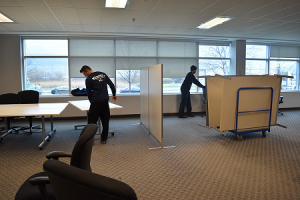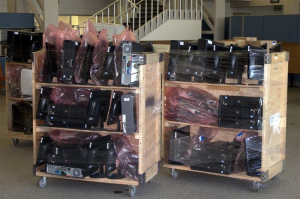 If you are planning to move a business you have a lot of organising to prepare. Even a small office move can be a huge task. But don’t worry as our short guide on how to tackle this task head on is going to help you plan your move.
If you are planning to move a business you have a lot of organising to prepare. Even a small office move can be a huge task. But don’t worry as our short guide on how to tackle this task head on is going to help you plan your move.
1. Initially Planning
First of all you want to make a timeline and hopefully you are in the planning stages months ahead of the move. If you are the boss you don’t just decide to move the office one day. You need to plan all the packing, the moving, the unpacking and getting everything up and running again.
Odds are that you business can’t suffer from down time so you’ll need a second temporary location that staff will work from to keep thins running. That second site will need to be organised and then shut down once the move is complete.
2. Donate What is not Needed
Every office has a collection of things they don’t need. This is a perfect time for you to donate what is not needed to a local charity. If you are donating a lot you might even be able to get some media coverage. This will help you business and get your brand name out there in the community.
This will also save you money. If you are doing a self move or hiring a professional moving company you still need to pay for help to make the move happen. Donating old office equipment reduces the amount of equipment you need to move and it also gives you points for karma!
3. Are you using a Moving Company?
If you are then plan ahead by at least a few months. Be sure to get several quotes and get real hard evidence that the removal company has the right insurance to cover a commercial move. As their insurance policy may only cover domestic moving. If you are going to get the help of the moving company for packing then you need to put some system in place for them to follow so you know what wen’t into what packing crates.
Also be sure to throw out everything that is not needed or being donated. Remember that a moving company is a ‘moving company’ and their job is to not sort though your things. Their job is to pack and move. So they will pack everything even if it should be thrown out.
4. That System… Mark your Boxes/Crates
Create a small system that lets you know what went into which box. It’s very simple to do in fact. Print some sticky labels and number them. Or just write on them. Then stick them on the boxes or packing crates that will be used.
From there use a notebook or crate a excel spreadsheet to keep notes. Use detailed notes for what is in each box or just use a general category like ‘computer cables’ for example.
 5. When Moving Computers and Monitors…
5. When Moving Computers and Monitors…
Moving blankets are ideal here. A moving blanket is not a fluffy blanket like you sleep in. It’s more like a highly durable outdoor blanket you would take to a picnic in the evening. They are strong and really protect what you wrap inside.
It’s best to bubble wrap the computers first and never just place them into boxes directly. To take things one step further before moving any computer equipment you should speak with your IT team to make sure everything is backed up in case equipment is damaged in the move.
The other option is to use shelf trollies like show in the photo to the right. The best option to move you computer equipment safely is to use a combination of both!
6. Get Commercial Moving Insurance
If you are using a removal company you need to fully vet their insurance. You can go as far as asking for policy numbers and then calling the insurance provide for that policy and ask what is covered and what is not.
If you are self moving then you need to organise moving insurance. Odds are that you business insurance does not cover property taken off the premises unless it’s for a specific reason such as client meetings or prospecting. It’s best to start by just calling you business insurance provider and asking what policy add-ons they offer for moving premises. You need to be sure that a new policy covers business property damaged during transit.
This becomes even more important if you are hiring trucks for a self move. If you hire trucks for the day or a few days they likely wont come with insurance that is adequate.
Fail to Plan and Plan to Fail
Hopefully these tips have helped you understand what is needed to organise a commercial move become seamless. You don’t want to be stuck on the side of the road with a broken down truck not knowing what to do. If you don’t plan then you will fail. So get planning!